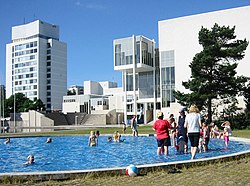Tapiola
|
Tapiola Hagalund |
|
|---|---|
| District of Espoo | |

The Espoo cultural centre and the Keskustorni (central tower)
|
|
| Etymology: Finnish: Tapio, a forest spirit in Finnish mythology | |
 Location of Tapiola (red) within Espoo (light green) and Suur-Tapiola (dark green) |
|
| Coordinates: 60°10′32″N 24°48′09″E / 60.17556°N 24.80250°ECoordinates: 60°10′32″N 24°48′09″E / 60.17556°N 24.80250°E | |
| Country |
|
| Municipality |
|
| Region | Uusimaa |
| Sub-region | Greater Helsinki |
| Main District | Suur-Tapiola |
| Inner District(s) | Itäkartano, Länsikorkee, Otsolahti, Tapiolan keskus |
| Area | |
| • Total | 3.5 km2 (1.4 sq mi) |
| Population (2012) | |
| • Total | 9,325 |
| • Density | 2,700/km2 (6,900/sq mi) |
| Languages | |
| • Finnish | 89.9 % |
| • Swedish | 6.4 % |
| • Other | 3.7 % |
| Postal Code(s) | 02100, 02120 |
| Jobs | 7,483 |
| Website | www |
Tapiola (Finnish pronunciation: [tɑpiolɑ]; Swedish: Hagalund) is a district of the municipality of Espoo on the south coast of Finland, and is one of the major urban centres of Espoo. It is located in the western part of Greater Helsinki. The name Tapiola is derived from Tapio, who is the forest god of Finnish mythology, especially as expressed in the Kalevala.
Tapiola was largely constructed in the 1950s and 1960s by the Finnish housing foundation and was designed as a garden city. It is the location of the Espoo cultural centre, the Espoo Museum of Modern Art (EMMA), the Espoo city museum, and the Espoo City Theatre.
According to the Finnish National Board of Antiquities, Tapiola was the largest and most valuable example of the 1960s construction ideologies in Finland. Its architecture and landscaping that combines urban living with nature has attracted tourists ever since.
Tapiola was one of the first post-war "new town" projects in Continental Europe. It was created by a private non-profit enterprise called Asuntosäätiö (the Housing Foundation), which was established in 1951 by six social trade organisations including the Confederation of Finnish Trade Unions, the Central Organisation of Tenants, the Mannerheim Child Welfare Federation, the Finnish Federation of Civilian and Military Invalids and the Civil Servants' Federation.
The project was conceived, built and managed by Heikki von Hertzen, the executive of the Asuntosäätiö and garden city advocate. Under Von Hertzen's leadership, the Housing Foundation bought 660 acres of forest land, six miles from the centre of Helsinki, and set out to create an ideal garden city. The role of the Housing Foundation included financing the project and overseeing the planning and building process so as to ensure consistency within different areas of the town. The Housing Foundation's unique combination of various socio-political organisations facilitated the negotiation of funds with governmental bodies. Von Hertzen set out to create a modern urban environment that would address the housing shortage in Helsinki and would be both economically viable and beautiful. Tapiola did not form part of any wider plan for Finland’s development other than von Hertzen’s Seven Towns Plan, a response to urban sprawl in Helsinki.
...
Wikipedia
